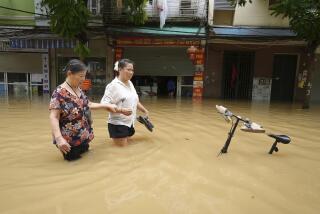Search for Malaysia Airlines jet focuses on waters off Vietnam
BEIJING — Search-and-rescue teams Thursday zoomed in on shallow waters off the southeastern coast of Vietnam looking for Malaysia Airlines Flight 370 after Chinese satellite photos appeared to show large objects floating in the sea.
The findings raised fragile hopes that the 5-day-old mystery of the plane’s disappearance might at last be solved, but officials warned it could be yet another tantalizing clue that proved a dead end.
“We will not give up on any suspected clue that is found,” Chinese Premier Li Keqiang said Thursday at a meeting of the National People’s Congress.
The area where the satellite spotted the floating objects, about 300 miles southeast of Ho Chi Minh City, Vietnam, and close to the plane’s flight path from Kuala Lumpur to Beijing, had already been thoroughly searched, Vietnamese officials said Thursday.
A veritable armada of ships, aided by search-and-rescue planes and satellites, have been scouring the waters and jungles of Southeast Asia looking for the Boeing 777 and its 239 missing passengers and crew.
At the latest count, there were 42 ships and 39 aircraft searching the region. Twelve countries are now involved, with Japan, India and Brunei the latest to pitch in.
Malaysian planes were on their way Thursday morning to search for the floating objects.
The plane vanished at 1:30 a.m. Saturday.
Hopes have been raised and dashed repeatedly in the ensuing days, as rescue teams have pulled various objects from the sea — garbage, rafts, life preservers and possibly even a body — that proved to be unrelated to the jetliner.
Frustrations were beginning to turn to recriminations and finger-pointing by Wednesday, with Chinese state media suggesting that Malaysia was concealing information and Vietnam suspending its role in the search.
Malaysian officials defended their handling of the frustrating effort.
“This is unprecedented what we are going through. Coordinating so many countries together is not something that is easy. We are looking at so many vessels and aircraft, so many countries,” acting Transportation Minister Hishamuddin Hussein said at a stormy televised news conference late Wednesday in Kuala Lumpur.
The floating objects detected by the Chinese satellite are large, each about the size of a basketball court. On its website, China’s State Administration for Science, Technology and Industry for National Defense released photos and described the objects as 43 by 59 feet, 46 by 62 feet and 79 feet by 72 feet.
The photos were taken at 11 a.m. Sunday, more than 24 hours after the flight disappeared from radar. The agency did not explain the delay.
“We cannot be sure [the debris detected by satellite] was from the missing flight,” civil aviation chief Li Jiaxiang told Chinese radio reporters Thursday morning in Beijing.
In recent days, investigators have been shifting their search efforts westward toward India, based on hints that the plane might have traveled for hours after it disappeared from civilian radar 50 minutes after takeoff.
Malaysian officials said Wednesday that their military radar had detected an unidentified aircraft about 2:15 a.m. Saturday over the Strait of Malacca, about 330 miles west of the intended flight path.
The Wall Street Journal reported Thursday that data from Rolls-Royce, the manufacturer of the airplane’s engines, suggested that the flight was in the air for up to four hours after its disappearance.
Jason Middleton, head of the school of aviation at the University of New South Wales in Sydney, theorized that the pilots might have passed out for lack of oxygen and that the plane kept going until it ran out of fuel.
“It suggests perhaps a decompression either because of an explosion or a problem with the airplane structure. If they turned to the west, looking for the shortest way back to a place to land, and passed out, the plane would have kept heading west,” said Middleton on Wednesday. “It is just a hypothesis that is not particularly likely, but all the likely options by now have been eliminated.”
Frustration is running high, with both China and Vietnam lashing out at the Malaysians’ handling of the investigation.
“We’ve decided to temporarily suspend some search-and-rescue activities, pending information from Malaysia,” Vietnam deputy transportation minister Pham Quy Tieu told reporters Wednesday. “We’ve asked Malaysian authorities twice, but so far they have not replied to us.”
China’s Communist Party-controlled Global Times also blasted the Malaysian government’s conflicting statements in an editorial Wednesday.
“We don’t know which information published by Malaysia is true and which is false, or whether they have released all the information they have so far,” the editorial said. “Is the Malaysian military intentionally hiding something?”
The Chinese Foreign Ministry was only slightly less withering, with spokesman Qin Gang saying at a briefing in Beijing, “Right now there is a lot of information, and it’s pretty chaotic, so up to this point we too have had difficulty confirming whether it is accurate or not.”
Of the 227 passengers aboard the missing plane, 159 were Chinese nationals and many others were ethnic Chinese.
At a hotel in Beijing, family members waited in a conference room, hoping for any nugget of new information.
“My only hope is for my son to be back. This is more important than anything else,” murmured a woman in her 50s, her face red and puffy, who was assisted by two family members as she walked outside the room.
Families were told Thursday morning by Malaysian officials that there was no indication that the 53-year-old pilot of the aircraft, Zaharie Ahmad Shah, had any psychological problems or impairments that might have led to the tragedy.
The search has already surpassed the 36 hours it took in 2009 to locate the debris from an Air France flight from Rio de Janeiro to Paris that crashed in the Atlantic.
Experts agreed that this effort was unprecedented in its complexity because of the number of countries involved, many of which have competing territorial claims in the region.
“The plane is from Malaysia. Most of the area where they are searching is Vietnam. The flight was headed to Beijing and had so many Chinese passengers,” said Gao Yuanyang, a professor at the Beijing University of Aeronautics and Astronautics. “It is rare to have so many countries involved in a plane crash.”
Australian expert Middleton said, however, that Malaysia had been right to start the search where the plane first lost contact with civilian radar, before expanding the area.
“The farther away you search, the larger the search area becomes,” he said. “I can’t say that any other country would have done it differently or much better.”
Nicole Liu and Tommy Yang of The Times’ Beijing bureau contributed to this report.
More to Read
Sign up for Essential California
The most important California stories and recommendations in your inbox every morning.
You may occasionally receive promotional content from the Los Angeles Times.










